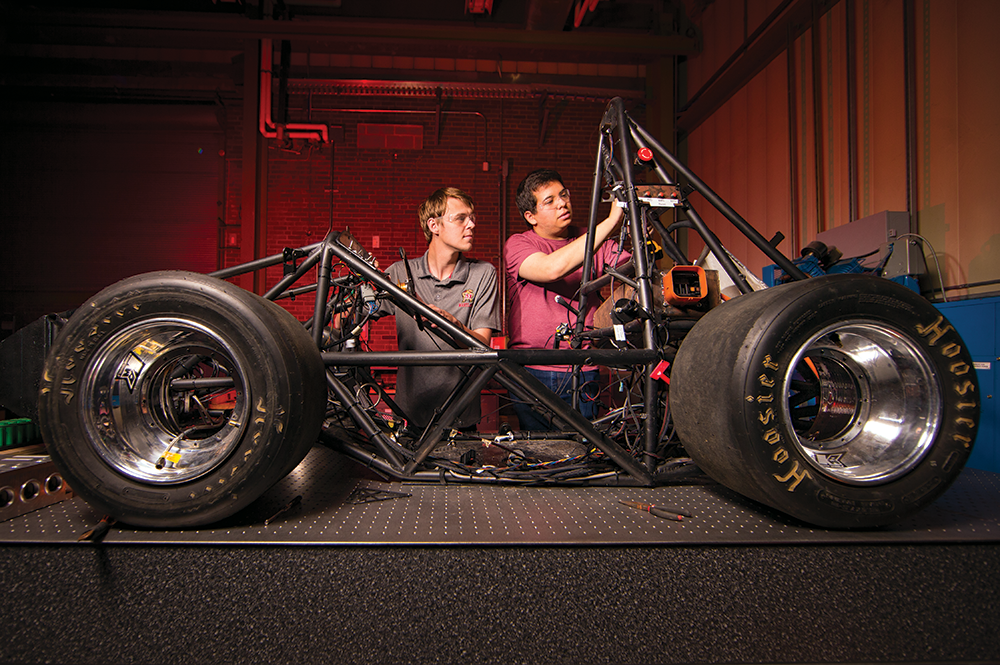News Story
Become a Contender: Electric Racecar

Terps Racing members Preston Der (left) and Garrison Case with the electric racecar. Photo: John T. Consoli
Elon Musk once said, “When something is important enough, you do it, even if the odds are not in your favor.” Musk’s wisdom encapsulates the origin story of Terps Racing’s latest iteration—an electric Formula car—pretty succinctly. Borne from a capstone course taught by Professor Alireza Khaligh, the two-year odyssey to build Maryland’s first electric racing car has had its fair share of obstacles: finding space to build; conquering a 100-page SAE International rule book; navigating the steep learning curve of an emerging technology. With an established track record in combustion Formula and Baja-style racing, the new Terps Racing crew was entering uncharted territory by building an electric car.
But being a first is an incredible motivator; what should have taken years to develop was accomplished in mere months, blazing a new trail for a 30-year-old club and inspiring students with what is, without a doubt, the future of automobile engineering.
As one of the Mpact Challenge projects, Terps Racing had the means to build both a car and a team, allowing many of the students to work full- or part-time on the car last summer under the guidance of Khaligh and two graduate students. The team encompasses almost every engineering discipline in the school and is mostly composed of undergraduates. The vehicle, which will don a sleek black paint job when complete, has the look and feel of a standard Formula vehicle, with a few notable exceptions: it’s significantly quieter and produces no greenhouse emissions, which itself creates a new set of challenges. To tackle the design of an electric car, they split into teams of 3–5 students, each responsible for taking care of one part of the vehicle, such as sensors, controls, battery, or motors. As the car progressed, they tested it in the parking lot next to the A.V. Williams Building or took it over to Lot 1. By summer’s end, they had a working car and a tight-knit club.
“We’re the real deal,” says electrical engineering sophomore Melissa Kelley, who previously worked on the Terps Racing Formula team. “We’re the first group to do this at UMD. It was an incredible opportunity to work on this project every day over the summer and, as an electrical engineer, to have a bigger electrical and computer aspect in a car. Plus, it was a lot of fun.”
“I want to give them a real-world, hands-on experience,” says Khaligh. “Most of the time college students, especially undergraduates, are just taking courses and learning fundamentals. That’s definitely needed, but this helps them see how they can translate all the knowledge they’ve gained into a real environment and technology.”
“We’re the real deal ... the first group to do this at UMD. Plus, it was a lot of fun.”
The experience has also given the students an edge as they prepare for post-graduate work, according to Kelley.
“It’s a really great thing to be able to talk about in job interviews,” she says. “Potential employers will ask me about the things I’ve done, and I can talk about the Terps Racing experience.”
With the Mpact Challenge fund over, the team is vying for additional funding to sustain the club and build a new chassis optimized for electric racing. At the end of the year, they’ll also need to find a new space to work. The team, with Khaligh as lead, is up for the challenge.
“I hope we can continue,” he says. “I have loved working with these students. They are incredibly motivated and have brought a fresh look and real enthusiasm to this project.”
This story first appeared in the Spring 2020 issue of Engineering at Maryland magazine.
Watch to learn more about Terps Racing:
Published March 15, 2020









